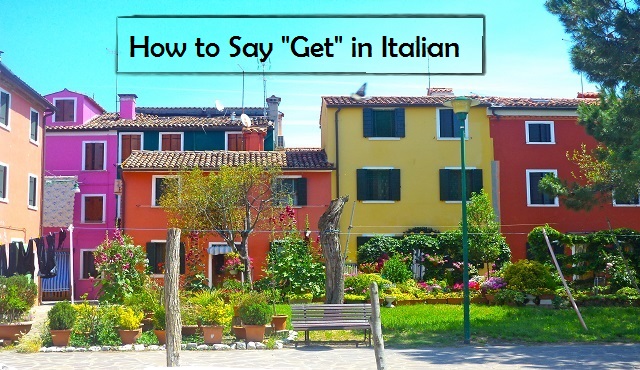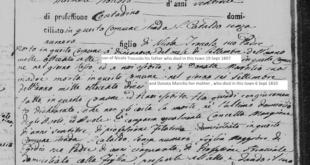At first glance, it seems easy to say “get” in Italian. The verb prendere translates as “to get.” But, the verb prendere actually has the specific meaning of “to procure something.”
In English conversation, which is typically less formal than written English, the verb to get is used in many more ways and conveys many more meanings than the verb prendere does in Italian. We English speakers rely on our basic understanding of what is going on in any given conversation to come up with the meaning of the verb to get. Instead, in both written and conversational Italian, the use of the verb to get is more specific than it is in English.
Many Italian verbs are used to translate the different meanings behind the English verb to get. Here are a few Italian verbs lifted from the Italian — English dictionary Word Reference (www.wordreference.com) as examples: ricevere (to receive/get something), portare (bring/get something), arrivare (arrive/get somewhere), capire and comprendere (understand something).
Just to make things a little more complicated… in an ordinary conversation, we all often describe what we have “got” to do. And, when we refer to activities of daily living in Italian, this means that the verb refers back to ourselves. And therefore… the Italian verb that we use must be reflexive.
I’ll try to get you to see how this works by first listing some common Italian reflexive verbs that translate as “to get” in Italian. Take a look at the table below:
| alzarsi | to get up |
| annoiarsi | to get bored |
| arrabbiarsi | to get angry |
| bagnarsi | to get wet to take a bath |
| laurearsi | to get a university degree to graduate |
| mettersi mettersi qualcuno nei guai |
to put on clothing to get (oneself) in trouble |
| preoccuparsi | to get worried to worry |
| prepararsi (per) | to get ready (for) |
| riprendersi | to get better to recover |
| spogliarsi | to get undressed |
| sposarsi | to get married |
| vestirsi svestirsi |
to get dressed to get undressed |
Below are some example sentences taken from what we all do in a normal day, many of which use the reflexive verbs from the previous table. The Italian subject pronoun “io,” meaning “I” is included in the Italian examples, although io is almost always omitted with reflexive verbs (as in most general conversation). Parentheses have been used in the Italian sentences as a reminder of this fact.
In the same way, parentheses are used in the English translation to indicate Italian reflexive pronouns that are not necessary in English. But, hopefully it will be useful to learn to think in Italian before translating into correct English.
Also remember that the simple present tense in Italian can have several different meanings in English. The simple phrase“Io vado,” for instance, can be translated as: “I go,” “I am going” or “I do go.”
Now, I think we understand enough about how Italian works that we are ready to get going with our examples!
Getting up in the morning:
| (Io) Mi sveglio. | I wake up. (lit. I wake myself up.) |
| (Io) Mi alzo. | I get up. (lit. I get myself up.) |
| (Io) Mi alzo presto. | I get (myself) up early. |
| (Io) Mi alzo alle sei. | I get (myself) up at 6 AM. |
| (Io) Mi alzo tardi domani. | I am going to get (myself) up late tomorrow. |
Getting ready to go out for the day:
| (Io) Mi faccio il bagno. (Io) Mi faccio una doccia. |
I take a bath. (lit. I make myself the bath.) I take a shower. (lit. I make myself a shower) |
| (Io) Mi lavo. | I wash myself. |
| (Io) Mi asciugo. | I dry myself off. |
| (Io) Mi pettino. | I comb (myself) my hair. |
| (Io) Mi preparo per il lavoro. | I get (myself) ready for (the) work. |
| (Io) Mi vesto. | I get (myself) dressed. |
| (Io) Mi metto i vestiti. | I put on (myself) the clothes. |
| (Io) Mi trucco. | I put on (myself) makeup. |
| (Io) Mi metto la giacca e le scarpe. | I put on (myself) the jacket and the shoes. |
| (Io) Mi sento molto bene! | I feel very well! |
| Vado al lavoro./ Vado a lavorare. | I go to work. |
At the end of the day:
| Torno a casa. | I return home. |
| (Io) Mi tolgo la giacca. | I take off (myself) the jacket. |
| Preparo la cena per la famiglia. | I make the dinner for the family. |
| Alle nove (io) mi svesto. | At nine I get (myself) undressed. |
| (Io) Mi tolgo le scarpe. | I take off (myself) my shoes. |
| (Io) Mi metto il pigiama e le ciabatte. | I put on (myself) (the) pajamas and slippers. |
| (Io) Mi rilasso. | I relax (myself). |
| (Io) Mi riposo. | I rest (myself). |
| (Io) Mi addormento. | I fall (myself) asleep. |
Three more important examples are listed below. The first example is interesting because one might be tempted to translate the phrase — incorrectly of course — “I have decided to marry myself!” But, now that we know that an important function of Italian reflexive verbs is to render the idea “to get,” the sentence structure in Italian for “Ho deciso di sposarmi,” makes perfect sense. Notice that the reflexive pronoun mi is attached to the end of the infinitive verb sposarsi.
The second examples are about “getting in trouble.” These are phrases that are good to know but hopefully they will not have to be used on a daily basis!
| Ho deciso di sposarmi. | I have decided to get married. |
| Non metterti nei guai! | Don’t get (put) yourself in trouble! |
| Mi sono messo nei guai. | I got (put) myself in trouble. |
Remember how to use Italian reflexive verbs when talking about things you have ” to get” and I guarantee you will use the every day!
If you’d like to read the earlier posts in the series, “Italian Phrases We Use EVERY Day!” just click HERE
 Fra Noi Embrace Your Inner Italian
Fra Noi Embrace Your Inner Italian








2 comments
Pingback: Impersonal Phrases with Italian Reflexive Verbs – Fra Noi
Pingback: Italian Phrases We Use EVERY Day!® The many uses of the Italian Verb “Prendere” | Conversational Italian!